We provide Grafted Rare cactus plants. Instructions How to graft rare cactus
All cactuses here are on sale We provide Grafted Rare cactus plants, wide amount of rootstocks Grafting cactus plants is a straightforward method of propagation which even a novice gardener can try. We have different stocks for sale grafting instructions on how to graft a cactus.
Rootstock, Stock - The lower portion of the graft. The supporting structure.
Scion - The upper portion of the graft. This is the section that will develop most of the above ground growth.
Vascular Cambium (Core) - is a lateral meristem in the vascular tissue of plants. It is a cylinder of unspecialized meristematic cells that divide to give rise to cells that further divide, differentiate and specialize to form the secondary vascular tissues. This also transports nutrients throughout the cactus and plays an important part in the fusing of grafts.
Meristematic Cells (Undifferentiated cells) - "Unassigned" cells that form into different plant organs. Mostly found in the Shoot Apical Meristem (SAR)
Shoot Apical Meristem - This is the point of growth. With cacti it is usually the very tip where all of the ribs meet and the areoles come out. This is where most of the growth is located.
Why grafting
The main reason for grafting cacti, is to get faster growth. Some species are incredibly slow (and rare) and grafting is a good way to propagate them faster.
Because grafting increases growth so much, it may also make the cacti scion (top) grow funny or unlike a seed grown plant. Some rootstocks make the scion more "deformed" looking than others (Pereskiopsis is notorious for this).
Grafting also enables colored and albino cacti that do not contain chlorophyll, to be kept alive. The scion in this case is totally dependent on the nutrients supplied by the rootstock.
Grafting is also used for speeding the grows of unusual cactus forms: monstrous crested forms
Attention
Before grafting you must realize there is risk in doing this. You are, in fact, cutting your cactus in half. There is the risk of them getting infected, or making a bad join and having the scion, or worse, the scion and rootstock, die. Be sure you are willing to risk your plants, and be sure you are ready to try grafting. Stay clean and work fast and steady and things should be ok.
Common species used as stocks for Grafting Cacti
The stocks from Rain Forest (Selenicereus grandiflorus, Hylocereus undatus, Pereskiopsis spathulata) could not grow long time. They could not get completely dry out. That is why you couldn graft on this stocks scions from deserts because they need not to get water during November up to March.
Garden Centers sale non-chlorophyll cacti grafted on Hylocereus undatus stocks. This stock from Rain Forest has a very fast growing ability. When the sciens is young, it can grow also very fast. When the skin become harder, it could not more grow and get cracks. It could lead to rot. I tried to buy them and they lived only for one - two years. I grafted them on more slowly growing stocks. Now they are alive for many years.
Step by step instructions on how to graft on Opuntia compressa stock. The classical methods. (recommended by www.cactus-art.biz)
There is not only one method for grafting, but many. Here I suggest some examples, but you can adapt the techniques to your own needs, and change them according to the season, size of the stock and scion, species etc...
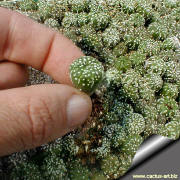 | 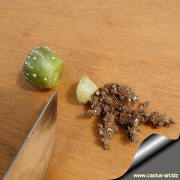 | ||||
| Choose a healthy young cladode (maximum 1 year old) | From a single cladode it is possible to obtain two grafting stock A and B. | Pick up a seedling (In the example an Astrophytum cv. superkabuto) | Prepare the scion for the graft removing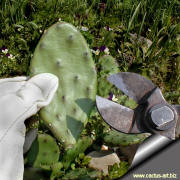 the root with a sharp knife. the root with a sharp knife. | ||
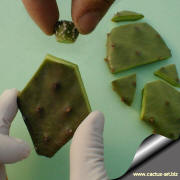 | 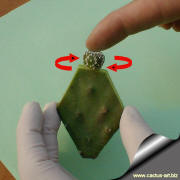 | 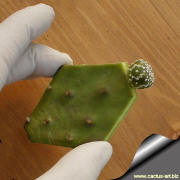 | 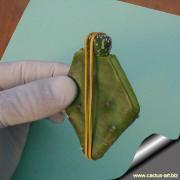 | ||
| Put the scion on the top of the stock. | Move the scion to expel air bubbles in the union zone. | Opuntia juice is very sticky and now the scion does not fall down not even if the stock is inclined | Use a rubber band to put the two parts together. | ||
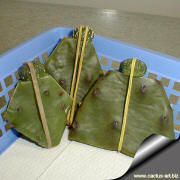 | 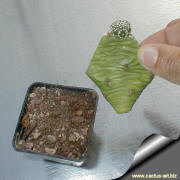 | 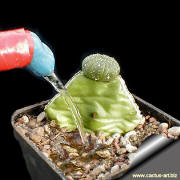 | 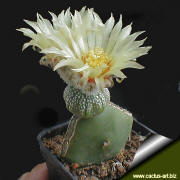 | ||
| Keep the graft in a shaded (or dark) warm room for about a week (or more) before potting... | After 10 days the plants are ready to be planted (it does not matter if the Opuntia is a little dried up: this is normal) | Let's water ... and then put the plants for some days in a shaded place before to move them among the other cactuses (end of April 2003) and... | ....the same plant (August 2003) first flowers!!! |
How to use rootstocks
All stocks from Rain Forest are for sale not rooted for $1.00.
They easily conform the roots. When you get them by mail, put the stocks in a plastic bag and keep them in dark place. For example, in kitchen cabinet for a two weeks. During this time the callus will formed and you can plant them in a pot. For soil use "Palm and Cactus" soil.
Grafting cactus plants is a straightforward method of propagation which even a novice gardener can try. We have different stocks for sale. Reasons for grafting, instructions on how to graft a cactus.
Grafted Cactus Care: Tips For Grafting Cactus Plants.The yellow mutant Thelocactus tulensis f. yellow for sale
instructions on how to graft a cactus. If you need instruction on how to graft a cactus, you can go below and find how to graft cactus on Opuntia, or I can email you my Article. My email address is mikglad@cox.net
What is grafting?
Grafting is the process of uniting two or more plant parts so that they grow as one. In practice this often means that a shoot or bud is grafted on a rooted stem. The bottom part of the graft is referred to as rootstock. The top of the plant is called the scion. Grafting typically consists of wounding the plants that are to be joined and then letting them heal in contact with each other. If the vascular tissue of both parts joins the graft has succeeded. The rootstock supplies the scion with water and nutrients.
Not all plants can be grafted together. Grafts are often only possible on near family members. Tobacco on tomato is possible but an apple tree on a cucumber rootstock is not possible. Since the Cactaceae family is a relatively young family, grafts between different species of cacti most often grow together. In fact I have not encountered one case of incompatibility in cacti at all.